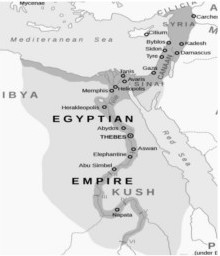Even this foundational myth of the Jewish religion is riven with invention and inconsistencies:
First of all, there is no evidence of any type that the Israelites were ever slaves in Egypt in the first place. They may have been: a) members of a the Canaanite immigration in advance of the Hyksos invasion of Egypt (around 1650 BC); b) even Hyksos themselves, since the Hyksos are suspected to have been of Hurrian origin (Abraham’s birthplace). Indeed Josephus identifies the Exodus with Manetho’s report of the emigration of 480,000 Hyksos “shepherd kings” from Egypt to Jerusalem (c 1550 BC). Apion even alleges that the heretic priest Osarseph changed his name to Moses and led a rebellion against Egypt. As archaeologist Jacquetta Hawkes states, “…they were wandering groups of Semites who had long come to Egypt for trade and other peaceful purposes;” or c) perhaps they were opportunistic members (habiru) of the coalition of the Sea Peoples (1200-900 BC), who devastated the Mycenean world until stopped (and enslaved?) by Egypt.

Egyptian Empire 1500-1200 BCE
Second, there is no record of any sort outside of biblical scripture that describes the ten plagues visited upon Egypt. This seems to be pure invention by Exilic scribes in Babylon.
Third, the passage of 603,550 armed men (Numbers 1:46) with wives, children and “a mixed multitude of non-Israelites” would have formed a parade of nearly 2 million, who if marching ten-abreast would form a column 150 miles long through the Sinai desert. Their place of habitation for 38 years after refusing to challenge the Canaanites, Kadesh Barnea, would have been the largest city in the Middle East, yet shows no signs at all of any habitation prior to 1000 BC.
Fourth, the culture of the earliest Israelite settlements is Canaanite, their cult objects are those of the Canaanite god El (before the adoption of the war god YHWH), the pottery remains are in the Canaanite tradition, and the alphabet used is early Canaanite. Almost the sole marker distinguishing the "Israelite" villages from Canaanite sites is an absence of pig bones.
Fifth, Kings 6:1 maintains that the Exodus occurred 480 years before the construction of Solomon’s Temple: that would be 1450 BC. At that time, not only was Egypt not afraid of a foreign enemy (Pharaoh’s ostensible motive for suppressing the Israelites), but the Israelites would have been escaping from Egypt to … Egypt! Canaan was part of the Egyptian empire (see map) until 1200 BC.
Finally, the widespread use of dromedaries (Exodus 9:3) was not known in Egypt until late in the first millennium BC. Also, at the time of the “invasion” of Canaan by the Israelites, Jericho was not a walled city at all, but was “small, poor, almost insignificant, and unfortified.”
~~~~~~~

